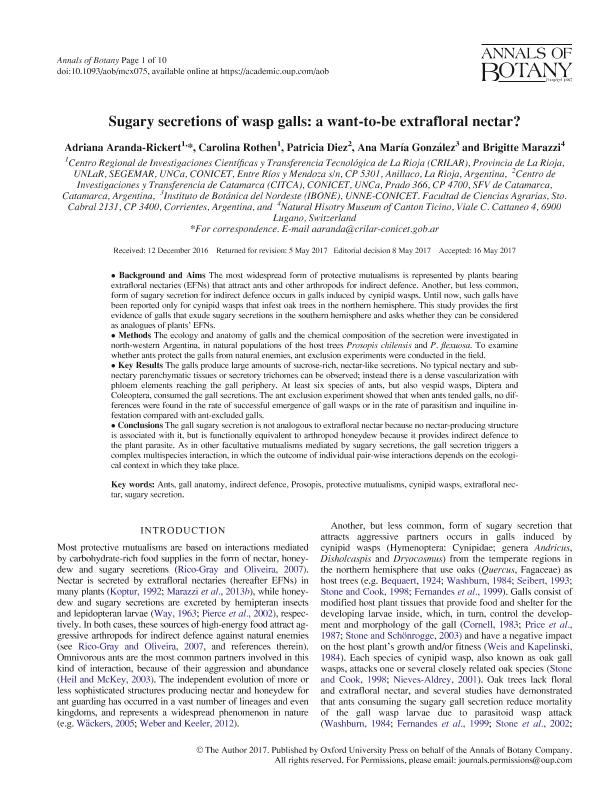Mostrar el registro sencillo del ítem
dc.contributor.author
Aranda Rickert, Adriana Marina

dc.contributor.author
Rothen, Carolina Paola

dc.contributor.author
Diez, Patricia Alejandra

dc.contributor.author
González, Ana María

dc.contributor.author
Marazzi, Brigitte

dc.date.available
2017-12-07T16:06:40Z
dc.date.issued
2017-06
dc.identifier.citation
Aranda Rickert, Adriana Marina; Rothen, Carolina Paola; Diez, Patricia Alejandra; González, Ana María; Marazzi, Brigitte; Sugary secretions of wasp galls: a want-to-be extrafloral nectar?; Oxford University Press; Annals of Botany; 120; 5; 6-2017; 765–774
dc.identifier.issn
0305-7364
dc.identifier.uri
http://hdl.handle.net/11336/29960
dc.description.abstract
Background and Aims: The most widespread form of protective mutualisms is represented by plants bearing extrafloral nectaries (EFNs) that attract ants and other arthropods for indirect defence. Another, but less common, form of sugary secretion for indirect defence occurs in galls induced by cynipid wasps. Until now, such galls have been reported only for cynipid wasps that infest oak trees in the northern hemisphere. This study provides the first evidence of galls that exude sugary secretions in the southern hemisphere and asks whether they can be considered as analogues of plants’ EFNs. Methods: The ecology and anatomy of galls and the chemical composition of the secretion were investigated in north-western Argentina, in natural populations of the host trees Prosopis chilensis and P. flexuosa. To examine whether ants protect the galls from natural enemies, ant exclusion experiments were conducted in the field. Key Results: The galls produce large amounts of sucrose-rich, nectar-like secretions. No typical nectary and sub-nectary parenchymatic tissues or secretory trichomes can be observed; instead there is a dense vascularization with phloem elements reaching the gall periphery. At least six species of ants, but also vespid wasps, Diptera and Coleoptera, consumed the gall secretions. The ant exclusion experiment showed that when ants tended galls, no differences were found in the rate of successful emergence of gall wasps or in the rate of parasitism and inquiline infestation compared with ant-excluded galls. Conclusions: The gall sugary secretion is not analogous to extrafloral nectar because no nectar-producing structure is associated with it, but is functionally equivalent to arthropod honeydew because it provides indirect defence to the plant parasite. As in other facultative mutualisms mediated by sugary secretions, the gall secretion triggers a complex multispecies interaction, in which the outcome of individual pair-wise interactions depends on the ecological context in which they take place.
dc.format
application/pdf
dc.language.iso
eng
dc.publisher
Oxford University Press

dc.rights
info:eu-repo/semantics/openAccess
dc.rights.uri
https://creativecommons.org/licenses/by-nc-sa/2.5/ar/
dc.subject
Extrafloral Nectar
dc.subject
Nectaries
dc.subject
Galls
dc.subject
Wasp Galls
dc.subject
Ants
dc.subject
Gall Anatomy
dc.subject
Indirect Defense
dc.subject
Prosopis
dc.subject
Protective Mutualisms
dc.subject
Cynipid Wasps
dc.subject
Sugary Secretion
dc.subject.classification
Otras Ciencias Biológicas

dc.subject.classification
Ciencias Biológicas

dc.subject.classification
CIENCIAS NATURALES Y EXACTAS

dc.title
Sugary secretions of wasp galls: a want-to-be extrafloral nectar?
dc.type
info:eu-repo/semantics/article
dc.type
info:ar-repo/semantics/artículo
dc.type
info:eu-repo/semantics/publishedVersion
dc.date.updated
2017-11-24T13:39:22Z
dc.identifier.eissn
1095-8290
dc.journal.volume
120
dc.journal.number
5
dc.journal.pagination
765–774
dc.journal.pais
Reino Unido

dc.journal.ciudad
Oxford
dc.description.fil
Fil: Aranda Rickert, Adriana Marina. Consejo Nacional de Investigaciones Científicas y Técnicas. Centro Regional de Investigaciones Científicas y Transferencia Tecnológica de La Rioja. - Universidad Nacional de La Rioja. Centro Regional de Investigaciones Científicas y Transferencia Tecnológica de La Rioja. - Universidad Nacional de Catamarca. Centro Regional de Investigaciones Científicas y Transferencia Tecnológica de la Rioja. - Secretaria de Industria y Minería. Servicio Geológico Minero Argentino. Centro Regional de Investigaciones Científicas y Transferencia Tecnológica de La Rioja. - Provincia de La Rioja. Centro Regional de Investigaciones Científicas y Transferencia Tecnológica de La Rioja; Argentina
dc.description.fil
Fil: Rothen, Carolina Paola. Consejo Nacional de Investigaciones Científicas y Técnicas. Centro Regional de Investigaciones Científicas y Transferencia Tecnológica de La Rioja. - Universidad Nacional de La Rioja. Centro Regional de Investigaciones Científicas y Transferencia Tecnológica de La Rioja. - Universidad Nacional de Catamarca. Centro Regional de Investigaciones Científicas y Transferencia Tecnológica de la Rioja. - Secretaria de Industria y Minería. Servicio Geológico Minero Argentino. Centro Regional de Investigaciones Científicas y Transferencia Tecnológica de La Rioja. - Provincia de La Rioja. Centro Regional de Investigaciones Científicas y Transferencia Tecnológica de La Rioja; Argentina
dc.description.fil
Fil: Diez, Patricia Alejandra. Consejo Nacional de Investigaciones Científicas y Técnicas. Centro de Investigaciones y Transferencia de Catamarca. Universidad Nacional de Catamarca. Centro de Investigaciones y Transferencia de Catamarca; Argentina
dc.description.fil
Fil: González, Ana María. Consejo Nacional de Investigaciones Científicas y Técnicas. Centro Científico Tecnológico Conicet - Nordeste. Instituto de Botánica del Nordeste. Universidad Nacional del Nordeste. Facultad de Ciencias Agrarias. Instituto de Botánica del Nordeste; Argentina
dc.description.fil
Fil: Marazzi, Brigitte. Natural Hisotry Museum of Canton Ticino; Suiza
dc.journal.title
Annals of Botany

dc.relation.alternativeid
info:eu-repo/semantics/altIdentifier/doi/http://dx.doi.org/10.1093/aob/mcx075
dc.relation.alternativeid
info:eu-repo/semantics/altIdentifier/url/https://academic.oup.com/aob/article/120/5/765/3902986
Archivos asociados
